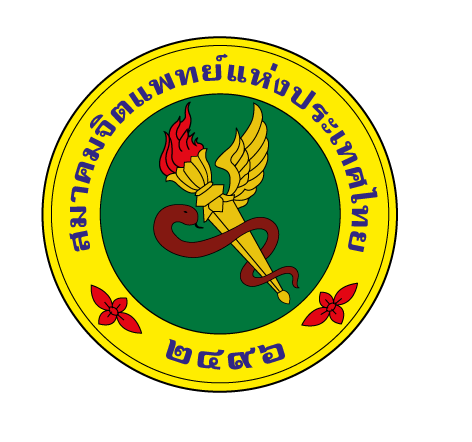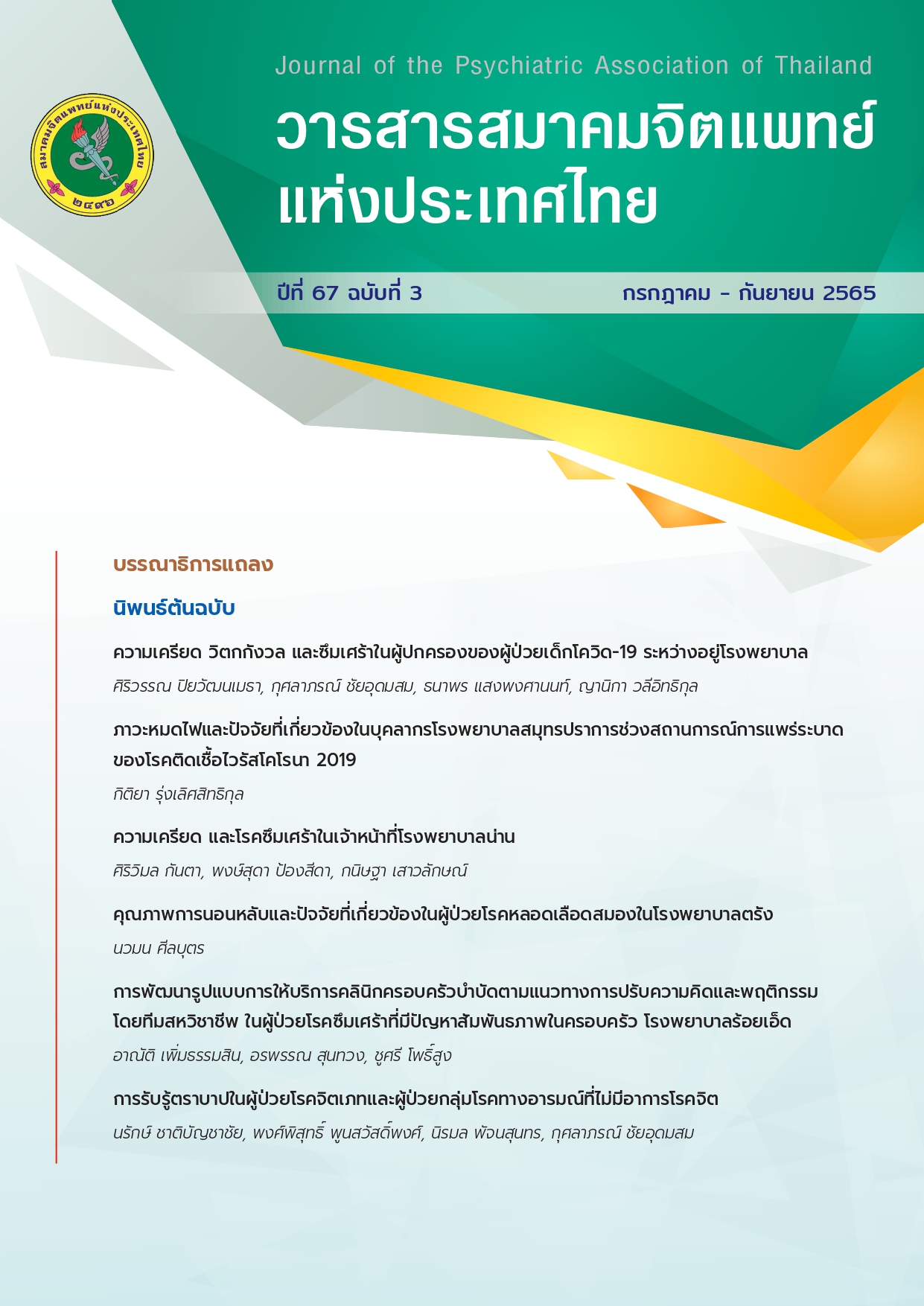ภาวะหมดไฟและปัจจัยที่เกี่ยวข้องในบุคลากรโรงพยาบาลสมุทรปราการ ช่วงสถานการณ์การแพร่ระบาดของโรคติดเชื้อไวรัสโคโรนา 2019
Main Article Content
บทคัดย่อ
วัตถุประสงค์ เพื่อสำรวจความชุกและศึกษาปัจจัยที่เกี่ยวข้องของภาวะหมดไฟในบุคลากรโรงพยาบาลสมุทรปราการ ช่วงสถานการณ์การแพร่ระบาดของโรคติดเชื้อไวรัสโคโรนา 2019
วิธีการศึกษา ศึกษาในบุคลากรที่ปฏิบัติงานในโรงพยาบาลสมุทรปราการอย่างน้อย 6 เดือน โดยใช้แบบสอบถามออนไลน์ประกอบด้วยแบบสอบถามข้อมูลพื้นฐาน ลักษณะงานและมุมมองต่อการทำงาน แบบประเมินภาวะหมดไฟ Maslach Burnout Inventory (MBI) แบบประเมินสุุขภาพจิต Depression Anxiety Stress Scales (DASS-21) แบบประเมินความเข้มแข็งทางใจ Resilience Quotient (RQ) วิเคราะห์ข้อมูลด้วยสถิติเชิงพรรณนาและหาความสัมพันธ์โดยใช้สถิติถดถอย Multiple logistic regression โดยเก็บข้อมูลช่วงเดือนมิถุนายน - กรกฎาคม 2564
ผลการศึกษา บุคลากรที่เข้าร่วมการศึกษาจำนวน 703 ราย (ร้อยละ 41.35) เป็นเพศหญิง ร้อยละ 87.06 อายุเฉลี่ย 37 ปี ประสบการณ์การทำงานเฉลี่ย 12 ปี พบบุคลากรมีความเสี่ยงสูงต่อภาวะหมดไฟ 76 ราย (ร้อยละ 10.81) โดยมีคะแนนด้านความอ่อนล้าทางอารมณ์ ในระดับสูง ร้อยละ 25.46 คะแนนด้านการลดคุณค่าความเป็นบุคคลในระดับสูง ร้อยละ 13.80 คะแนน ด้านความสำเร็จส่วนบุคคลในระดับต่ำ ร้อยละ 91.47 มุมมองต่อการทำงานส่วนใหญ่กว่าร้อยละ 90 มองว่าสามารถจัดการงานได้ มีสัมพันธภาพที่ดี และมีที่ปรึกษา สำหรับด้านอัตรากำลัง ค่าตอบแทนและทรัพยากรที่ได้รับการสนับสนุนยังไม่เพียงพอกว่าร้อยละ 60 ภาวะสุขภาพจิตด้านอารมณ์ซึมเศร้า วิตกกังวล และความเครียดที่อยู่ในระดับรุนแรงถึงรุนแรงที่สุด ร้อยละ 3.42, 5.83 และ 3.13 ตามลำดับ ระดับความเข้มแข็งทางใจต่ำกว่าเกณฑ์ ร้อยละ 16.50 หลังจากวิเคราะห์์ด้วยสถิติถดถอย Multiple logistic regression พบปัจจัยที่สัมพันธ์กับภาวะหมดไฟ ได้แก่ อายุต่ำกว่า 30 ปี (OR, 3.14 ; 95% CI, 1.33-7.41 ; P = 0.009) ปฏิบัติงานด่านหน้า (OR, 3.01 ; 95% CI, 1.02-8.84 ; P = 0.045) มีความเครียดสูง (OR, 4.60 ; 95% CI, 1.39-15.26 ; P = 0.013) และมีระดับความเข้มแข็งทางใจที่ต่ำกว่าเกณฑ์ (OR, 7.30 ; 95% CI, 2.74-19.39 ; P <0.001)
สรุป ช่วงสถานการณ์การระบาดของเชื้อไวรัสโคโรนา 2019 บุคลากรโรงพยาบาลสมุทรปราการมีความเสี่ยงสูงต่อภาวะหมดไฟ คิดเป็นร้อยละ 10.81 โรงพยาบาลควรมีระบบดูแลสุขภาพจิตในบุคลากรและติดตามดูแลอย่างสม่ำเสมอ ร่วมกับการสนับสนุนทรัพยากร ทั้งด้านอัตรากำลัง ความปลอดภัยในการทำงาน ค่าตอบแทนที่เหมาะสม รวมถึงการสนับสนุนทางสังคม โดยเฉพาะอย่างยิ่งในบุคลากรด่านหน้าและกลุ่มบุคลากรอายุน้อย เพื่อลดโอกาสเกิดภาวะหมดไฟในการทำงาน
คำสำคัญ ภาวะหมดไฟ บุคลากรโรงพยาบาล ภาวะสุขภาพจิตความเข้มแข็งทางใจ เชื้อไวรัสโคโรนา 2019
Article Details

อนุญาตภายใต้เงื่อนไข Creative Commons Attribution-NonCommercial-NoDerivatives 4.0 International License.
บทความที่ส่งมาเพื่อพิจารณา ต้องไม่เคยตีพิมพ์หรือได้รับการตอบรับให้ตีพิมพ์ในวารสารฉบับอื่น และต้องไม่อยู่ระหว่างการส่งไปพิจารณาในวารสารอื่น
เอกสารอ้างอิง
Department of Mental Health, Ministry of Public Health. Combat 4th Wave of COVID-19: C4. Nonthaburi: Department of Mental Health; 2020.
Ausanangkornchai S, Arunpongpaisal S, Silpakit P, Kittirattanapaiboon P, Juengsiragulwit D, Tantirangsee N, et al. International classification of disease for mortality and morbidity statistics: mental, behavioural of neurodevelopment disorders and related codes. Nonthaburi: Department of Mental Health; 2019. 330.
Suteerawut N. Burnout: Antecedents and prevention. J Educ Meas 2015; 32(91): 16-25.
Wannarit K. Burnout syndrome. 2019. [cited 2021 Feb 17]. Available from: https://www.si.mahidol.ac.th/sidoctor/e-pl/ articledetail.asp?id=1385
Maslach C, Leiter MP. Understanding the burnout experience: recent research and its implications for psychiatry. World Psychiatry 2016; 15(2): 103-11.
Maslach C, & Goldberg J. Prevention of burnout: New perspectives. Appl Prev Psychol 1998; 7: 63-74.
Trumello C, Bramanti SM, Ballarotto G, Candelori C, Cerniglia L, Cimino S, et. al. Psychological adjustment of healthcare workers in italy during the covid-19 pandemic: Differences in stress, anxiety, depression, burnout, secondary trauma, and compassion satisfaction between frontline and non-frontline professionals. Int J Environ Res Public Health 2020; 17, 8358.
Dobson H, Malpas C, Burrell A JC, Gurvich C, Chen L, Kulkarni J, Winton-Brown T. Burnout and psychological distress amongst Australian healthcare workers during the COVID-19 pandemic. Australasian Psychiatry 2021; 29(1): 26–30.
Lai J, Ma S, Wang Y, Cai Z, Hu J, Wei N, et al. Factors associated with mental health outcomes among health care workers exposed to Coronavirus disease 2019. JAMA Netw Open 2020;3:e203976.
Duarte I, Teixeira A, Castro L, Marina S, Ribeiro C, Jácome C, et. al. Burnout among Portuguese healthcare workers during the COVID-19 pandemic. BMC Public Health 2020; 20: 1885.
Sucaromana A. Resilience Quotient: RQ. JMPS 2016; 4(1): 209-20.
Worawasuwat N, Sukultong L, a Pisan-ake K, Mala M, Naowanit P. The development of model to enhancing psychological immunity and burnout prevention for health region 7 health officials: EPI-BP Model. Khonkaen: Mental Health Center 7; 2018. [cited 2021 Feb 24]. Available from: https://mhc7.go.th/archives/6623
Mental Health Center 7. Burnout questionnaire for public health officials. Khon Kaen; 2017. [cited 2021 Feb 24]. Available from:
https://mhc7.go.th/archives/5996
Pityaratstian N, Buathong N. Depression Anxiety Stress Scales; DASS-21. Department of Psychiatry Faculty of Medicine Chulalongkorn University. [cited 2021 Feb 15]. Available from: http://www.cumentalhealth.com/index.php?lay=show&ac=arti
cle&Id=539909324
Intasit S, Chulkeeree S. RQ: Resilience Quotient. Mental Health Academic Bureau, Department of Mental Health, Ministry of
Public Health; 2020.
Department of Mental Health. The survey found that the lockdown phase 3 Thai people feel “stressed-out of fire-depressed-want
to hurt themselves” increases. 2020. [cited 2021 Aug 8]. Available from: https://www.dmh.go.th/news-dmh/view.asp?id=30358.
Kijjanon N, Jongjareonkumchok A, Masnarakorn P. Burnout among staff nurses working in intensive care units. RNJ 2009; 15(1): 86-97.
Choon-ngarm N. Mental health and burnout among physicians in general hospital and community hospital in Nakhon Ratchasima province. J Ment Health Thai 2020; 28(4): 348-59.
Matsuo T, Kobayashi D, Taki F, Sakamoto F, Uehara Y, Mori N, et al. Prevalence of health care worker burnout during the Coronavirus disease 2019 (COVID-19) pandemic in Japan. JAMA Netw Open 2020; 3(8): e2017271.
Prasada K, McLoughlinc C, Stillmanb M, Poplaub S, Goelzb E, Taylorc S, et al. Prevalence and correlates of stress and burnout among U.S. healthcare workers during the COVID-19 pandemic: A national cross-sectional survey study. EClinicalMedicine 2021; 35. e100879.
Chirico F. Job stress models for predicting burnout syndrome: a review. Ann Ist Super Sanita 2016; 52(3): 443-56.
Hakanen J, Schaufeli W, Ahola K. The job demands-resources model: A three-year cross-lagged study of burnout, depression,
commitment, and work engagement. Work Stress 2008; 22(3):224–41.
Vichanjalearnsuk V, Supapong S. Job burnout and related factors among pharmaceutical representatives of international pharmaceutical company. TMJ 2015; 15(2): 225-31.
Inchaiya P, Phakthongsuk P. The factors associated with burnout among private hospital staff in Songkhla Province. JPMC 2021;38(2):142-51.
Dall’Ora C, Ball J, Reinius M, Griffiths P. Burnout in nursing: a theoretical review. Hum Resour Health 2020;18(41). doi:10.1186/
s12960-020-00469-9.
Theucksuban B, Nantsupawat R,Wichaikhum O. Factors influencing job burnout among professional nurses Maharajnakhonsithammarat Hospital. JTNMC 2008; 23(4):114-24.
Ferry AV, Wereski R, Strachan FE, Mills NL. Predictors of UK healthcare worker burnout during the COVID-19 pandemic. QJM-INT J MED 2021; 114(6):374-380.
Giuseppe M D, Nepa G, Prout T A, Albertini F, Marcelli S, Orrù G, et al. Stress, burnout, and resilience among healthcare workers during the COVID-19 emergency: The role of defense mechanisms. Int J Environ Res Public Health 2021; 18: e5258.
Ang SY, Uthaman T, Ayre TC, Mordiffi SZ, Ang E, Lopez V. Association between demographics and resilience – a crosssectional study among nurses in Singapore. Int Nurs Rev 2018; 65(3): 459-66.
Lasalvia A, Amaddeo F, Porru S, Carta A, Tardivo S, Bovo C, et al. Levels of burn-out among healthcare workers during the COVID-19 pandemic and their associated factors: a crosssectional study in a tertiary hospital of a highly burdened area of north-east Italy. BMJ Open 2021; 11: e045127.
Matsuo T, Taki F, Kobayashi D, Jinta T, Suzuki, Ayabe A, et al. กิติยา รุ่งเลิศสิทธิกุล Vol. 67 No.3: 2022 https://www.tci thaijo.org/index.php/JPATนิพนธ์ต้นฉบับ Journal of the Psychiatric Association of Thailand 255 Health care worker burnout after the first wave of the coronavirus disease 2019 (COVID-19) pandemic in Japan. J Occup Health 2021; 63: e12247.
Pfefferbaum B, Carol S. Mental health and the Covid-19 pandemic. N Engl J Med 2020; 383(6): 510-12.
Hert S D. Burnout in healthcare workers: Prevalence, impact and preventative strategies. Local Reg. Anesthesia 2020; 13: 171-83.
Maslach C. Burnout in health professionals. Psychol Health Med 2014: 427-30.
Cooke G PE, Doust J A, Steele M C. A survey of resilience, burnout, and tolerance of uncertainty in Australian general practice registrars. BMC Medical Educ 2013; 13: 2.
Trani M D, Mariani R, Ferri R, Berardinis D D, Frigo M G. From resilience to burnout in healthcare workers during the covid-19 emergency: The role of the ability to tolerate uncertainty. Front Psychol 2021; 12: e646435.
Coco M, Guerrera CS, Santisi G, Riggio F, Grasso R, Corrado DD, et al. Psychosocial impact and role of resilience on healthcare workers during COVID-19 pandemic. Sustainability 2021; 13: e7096.
Rieckert A, Schuit E, Bleijenberg N, Cate D ten, Lange W de, Ginkel JM, et al. How can we build and maintain the resilience of our health care professionals during COVID-19? Recommendations based on a scoping review. BMJ Open 2021; 11: e043718.


